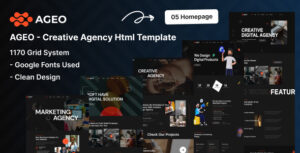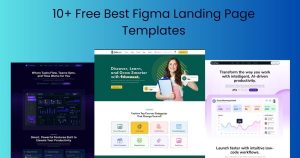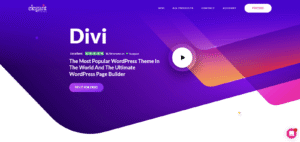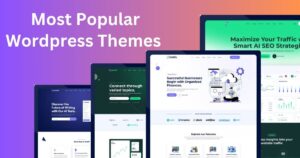A booking website template is an essential solution for businesses that rely on online reservations, appointments, or scheduling. Whether you run a hotel, travel agency, salon, or service-based business, a professional booking website template helps you manage bookings efficiently while improving customer experience.
In this guide, we’ll explore the features, benefits, and use cases of a modern booking website template, and why choosing the right booking design can increase conversions and customer trust.
A top-notch booking website template could be your secret weapon. You’ll discover how the right template can transform your website into a user-friendly powerhouse. You’ll learn how it can enhance user experience, boost your brand’s credibility, and ultimately drive more bookings.
Stay with us, and see how a simple template choice can revolutionise your business.
What Is a Booking Website Template?
A booking website template is a pre-designed website layout tailored for businesses that require an online booking system. These templates typically come with features such as integrated booking forms, payment gateways, calendar integration, and customer management systems.
Unlike generic website themes, booking templates are designed with a focus on:
-
Ease of use for customers making reservations
-
Customization options for businesses to match their brand
-
Mobile-friendliness for a seamless experience across devices
Key Features Of A Booking Website Template
Choosing the right booking website template is crucial for any business. It sets the foundation for customer interaction. An effective template offers essential features that enhance user experience. Let’s explore the key features that make a booking website template stand out.
Responsive Design
Responsive design ensures your website looks good on all devices. Whether accessed on a phone or laptop, the design adapts seamlessly. This enhances user satisfaction and keeps customers engaged. No more pinching and zooming on mobile screens.
User-friendly Interface
A user-friendly interface makes navigation simple for visitors. Clear layout and intuitive design guide users effortlessly. It reduces bounce rates and encourages bookings. Easy-to-use interfaces build trust and improve user experience.
Seamless Navigation
Seamless navigation helps users find what they need quickly. Organized menus and categories simplify the search process. Visitors can book services without hassle. Efficient navigation boosts customer retention and satisfaction.
Integrated Payment Systems
Integrated payment systems offer secure and fast transactions. Customers appreciate multiple payment options. This feature speeds up the booking process. It provides peace of mind for both the business and the customer.
Design Elements That Enhance User Experience
A well-designed booking website template enhances user experience by ensuring easy navigation and quick access to essential features. Clear layouts and intuitive buttons guide users smoothly through the booking process. Visually appealing elements like contrasting colors and readable fonts keep users engaged and satisfied.
Designing a booking website template is not just about making it look good—it’s about creating an experience that keeps users coming back. The design elements you choose can make or break the user experience. By focusing on visual appeal, consistent branding, and interactive elements, you can transform a standard template into a powerful tool for engagement and retention.
Visual Appeal
Visual appeal is the first impression your users get, and it matters immensely. A clean, modern design with the right color palette can create a welcoming atmosphere. Use high-quality images and ample white space to avoid overwhelming your visitors. Think about the last time you stayed on a website just because it was pleasant to look at. A visually appealing site can encourage users to explore further and spend more time on your pages.
Consistent Branding
Consistent branding ties your entire website together and reinforces trust. Make sure your logo, color scheme, and typography are consistent across all pages. This helps users recognize your brand instantly, whether they’re on the homepage or the booking page. Consider a time when you visited a website with mismatched fonts and colors. It likely felt disjointed and unprofessional. Consistency in design builds credibility and encourages users to book with confidence.
Interactive Elements
Interactive elements can enhance user engagement by making the browsing experience more dynamic. Features like clickable calendars, real-time availability checks, and interactive maps can streamline the booking process. Have you ever enjoyed using a website because it felt intuitive and responsive? Interactive elements not only make navigation easier but also provide users with a sense of control and immediacy in their booking journey. By thoughtfully incorporating these design elements, you elevate your booking website from a simple tool to a seamless experience. What design choices will you make today to enhance your users’ experience?
Optimizing For Mobile Devices
Optimizing for mobile devices is crucial for any booking website template. Mobile users expect a seamless experience. A poorly optimized site can drive users away. Make sure your site works well on phones and tablets. This is key for retaining visitors and improving conversions.
Mobile-first Strategy
Start with a mobile-first approach. This means designing for mobile devices first. Then, adapt the design for larger screens. Focus on what mobile users need most. Prioritize essential information. Make navigation simple and intuitive. This ensures your site meets the needs of mobile users.
Touch-friendly Controls
Design with touch in mind. Mobile users rely on touch. Buttons and links should be easy to tap. Avoid tiny controls that frustrate users. Use large buttons and ample spacing. This makes navigation smooth and user-friendly. Focus on touch-friendly design elements.
Fast Loading Times
Fast loading times are essential for mobile users. Slow sites lose visitors quickly. Optimize images and scripts for speed. Minimise HTTP requests. Use caching to improve load times. Mobile users expect quick access. Ensure your site loads quickly on all devices.
Effective Call To Actions
Enhance your booking website with compelling call-to-actions. Encourage users to book instantly with simple buttons. Boost engagement by using clear and inviting language.
Creating an engaging booking website template means having compelling calls to action (CTAs). These CTAs guide your users to take specific actions, like booking a service or signing up for updates. A strong CTA can turn a casual visitor into a loyal customer. But how do you craft CTAs that truly work? Let’s dive into some key strategies.
Placement And Visibility
Where you place your CTAs is crucial. They need to be visible without overwhelming your visitors. Think about a time when you visited a website and couldn’t find the ‘Book Now’ button. Frustrating, right? Position your CTAs where users naturally look, such as the top of the page or alongside key information. You should also make them stand out visually. Use contrasting colors that catch the eye without clashing with your overall design. Ensure they are large enough to be easily clickable, especially on mobile devices.
Persuasive Language
Words matter. They can inspire action or leave your users indifferent. Instead of using generic phrases like “Click here,” try something more engaging, like “Secure your spot today!” Use language that creates urgency or excitement. Consider what your users need or want. Are they looking for a hassle-free booking experience? Highlight that with phrases like “Book in just 3 clicks!” or “Instant confirmation.” Speak directly to their desires and needs.
Trial Offers And Discounts
Everyone loves a good deal. Offering trial periods or discounts can be a powerful motivator. Imagine you’re on the fence about a service, and you see a CTA offering a 20% discount for first-time bookings. Tempting, right? Incorporate these offers into your CTAs to encourage immediate action. Use phrases like “Try for free” or “Save 20% on your first booking.” Ensure the offer is clear and easy to understand. This transparency builds trust and encourages users to take the next step. By focusing on these elements, your CTAs can transform your booking website template into a conversion powerhouse. What changes can you make today to enhance your site’s CTAs?
Seo Strategies For Booking Websites
Booking websites need effective SEO strategies to thrive. With the right approach, they can attract more visitors and increase bookings. The following strategies can help your booking website stand out in search engine results.
Keyword Optimization
Identify relevant keywords for your booking website. Use tools like Google Keyword Planner. Focus on long-tail keywords. These can bring targeted traffic. Place these keywords naturally in titles, meta descriptions, and headers. Avoid keyword stuffing. This can harm your site’s ranking.
Local Seo Tactics
Local SEO is crucial for booking websites. Optimize your content for local searches. Include location-based keywords. Ensure your site is listed on Google My Business. Encourage customer reviews. These boost your local search presence. Make sure your contact information is consistent. This builds trust with search engines.
Content Marketing
Engaging content attracts and retains users. Create blog posts about travel tips or destination guides. Share customer stories and testimonials. Use high-quality images and videos. These engage visitors and improve SEO. Regularly update your content. This keeps your site fresh and relevant.
Utilizing Analytics To Boost Conversions
Analytics can significantly improve a booking website template’s effectiveness. By analyzing user behaviour, identify patterns to enhance user experience. This data-driven approach can boost conversion rates by optimising layout and features tailored to user preferences.
To truly maximise the potential of your booking website template, understanding and leveraging analytics is crucial. Analytics offer invaluable insights into how users interact with your site, which directly influences conversion rates. By effectively utilising analytics, you can enhance your user experience and ultimately boost conversions.
Tracking User Behaviour
Understanding how users navigate your booking website is key to identifying areas for improvement. Start by tracking basic metrics like page views, session duration, and bounce rates. Tools like Google Analytics can provide a wealth of data, helping you see which pages are most engaging and which ones may need a redesign. Imagine you’ve noticed that users frequently abandon your site on a specific page. This signals a potential issue that needs attention. Dig deeper to understand why this happens; perhaps the page is too slow, or the content is unclear.
Identifying Conversion Bottlenecks
Once you’ve gathered data on user behaviour, it’s time to pinpoint where users drop off in the conversion funnel. Look at your site’s checkout process: are there too many steps? Are users confused about pricing or availability? A personal experience can illustrate this: I once managed a booking site where users often left during the payment step. By simplifying the payment form and providing clear instructions, we increased our conversion rate by 20%. Sometimes small tweaks can lead to significant improvements.
A/b Testing
A/B testing is an effective strategy to find out what works best on your site. Create two versions of a webpage and see which one performs better in terms of conversions. This method allows you to test different elements, such as headlines, images, or call-to-action buttons. Consider testing something unexpected. What if changing the color of your “Book Now” button could increase clicks? Small changes can make a big difference, and A/B testing provides the evidence you need to make informed decisions. Are you taking full advantage of analytics to boost your website’s performance? By tracking user behaviour, identifying bottlenecks, and conducting A/B tests, you can refine your booking website template to better meet your users’ needs and drive higher conversions.
Incorporating Customer Feedback
Understanding customer feedback is crucial for a booking website template. It shows what users like and where they face challenges. This feedback helps improve the website’s features and user experience. By actively listening to customers, businesses can create a platform that meets user needs effectively.
Reviews And Testimonials
Reviews and testimonials are vital for understanding user experiences. They provide real insights into what users think of the booking process. Positive reviews build trust and encourage others to use the service. Displaying these on the website can enhance credibility.
Feedback Forms
Feedback forms are an easy way for users to share thoughts. They should be simple and quick to fill out. Ask specific questions to gather useful information. This data can reveal what aspects need improvement. It also shows users that their opinions matter.
Continuous Improvement
Continuous improvement is key for a successful booking website. Regularly update the site based on feedback. This keeps the site user-friendly and up-to-date. Analyze feedback trends to identify recurring issues. This proactive approach ensures a positive user experience.

Frequently Asked Questions
What Is A Booking Website Template?
A booking website template is a pre-designed layout for creating online booking systems. It streamlines the setup of reservation forms, calendars, and payment gateways. Templates are customizable, allowing users to tailor them to specific business needs. They save time and ensure a professional appearance for businesses offering booking services.
How Can I Customize A Booking Template?
Customizing a booking template involves modifying design elements and functionalities. You can change colors, fonts, and layouts. Add or remove features like calendars or payment options. Most templates offer user-friendly interfaces for easy adjustments. This flexibility ensures your booking site matches your brand identity and meets customer expectations.
Are Booking Templates Mobile-friendly?
Yes, most booking templates are mobile-friendly. They are designed to adapt to various screen sizes, ensuring users have a seamless experience across devices. Mobile-friendly templates improve user engagement and accessibility. This feature is crucial, as a significant portion of users book services through smartphones and tablets.
How Do Booking Templates Improve User Experience?
Booking templates enhance user experience by offering intuitive navigation and streamlined booking processes. They reduce complexity, making reservations quick and easy. Features like real-time availability checks and automated confirmations boost efficiency. A user-friendly design increases customer satisfaction, encouraging repeat business and positive reviews.
Conclusion
A booking website template simplifies your online reservation system. It’s a practical tool for businesses. Easy to customize, it fits various needs. Choose a template that suits your brand. Ensure it enhances user experience on your site. A good template can boost your bookings.
It saves time and effort. Plus, it keeps your site looking professional. Remember, a well-designed template attracts more visitors. So, pick wisely and watch your business grow. Investing in a reliable template is a smart choice. It’s the first step to efficient online bookings.
Looking for the best booking website templates? Browse our collection and find the perfect template for your business today!










